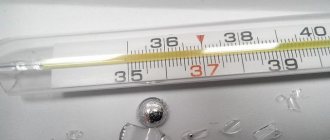Very often, people find themselves in a situation where a broken mercury thermometer leaves them bewildered. What to do, how to quickly and “painlessly” collect mercury, and where to send it for processing and storage in the future?
In this situation, at least one thing that is encouraging is that the vast majority know that mercury is dangerous and needs to be removed as quickly as possible.
Let's today touch on the very important topic of cleaning up mercury, both from a broken thermometer and in larger volumes. Although, in fact, the methodology for carrying out demercurization work (and this, by the way, is the scientific name for the process of removing and cleaning a room from mercury) does not in any way depend on the volume of mercury.
What is demercurization
An accidentally damaged thermometer or a mercury-containing light bulb can lead to disaster. The surfaces of the room become contaminated, and the air is poisoned by toxic fumes. Removing mercury waste is called demercurization.
The effectiveness of the neutralization process depends on the amount of the toxic chemical, the size of the room, and the choice of method of exposure - physical, chemical, or a combination of both. When working, use a demercurization kit. There are professional sets, used on an area of up to 20 m2, and household sets, up to 5 m2.
Demercurization kit
Demercurization kit is a specialized complete package, which is a set of devices designed to eliminate the consequences of leakage of heavy metal - mercury.
According to their intended purpose, the kits are divided into:
- Laboratory - used primarily for collecting small amounts of mercury in medical institutions, healthcare facilities and laboratories.
- Household - used for a single destruction of a household device (thermometer, lamp)
- Industrial. Industrial demercurization kits are used in manufacturing enterprises where heavy metal is a component of the device and the technological process as a whole. The industrial kit is designed for large-scale liquidation of mercury leaks and treatment of an area of 200 m2. The most commonly used is the laboratory package.
What not to do during demercurization
Silver metal is classified as class I in terms of the degree of danger, requiring certain disposal conditions. Often a person does not know what to do when a thermometer breaks at home. He is trying to collect mercury balls and call family members for help.
One broken device is not a disaster if measures are taken in time. Demercurization of mercury yourself at home is carried out according to the rules. In such cases, it is strictly prohibited:
- Use household appliances.
- Sweep with a broom.
- Use a rag.
- Dispose of in a container for solid waste (solid waste).
- Flush down the toilet.
- Burn.
- Bury into the soil.
Such actions will lead to the opposite result. The chemical will crumble into small pieces and scatter throughout the room, making it difficult to remove it. If you lack the skills or are unsure, it is better to call employees from an organization that deals with mercury waste.
When thrown into a trash container, toxic metal retains its toxic properties for a long time. Evaporating at any temperature, it pollutes the air and soil. Entering the human body through the respiratory system or digestive system, it causes serious problems.
Additional Information . Most often, troubles with a broken thermometer occur due to the negligence of children. Such medical devices must be used under adult supervision.
If you broke a mercury thermometer
In the very first minutes, people panic and many commit rash actions that can lead to more dire consequences.
If you do everything correctly, you will not only eliminate the source of danger, but also save yourself and your loved ones from such unpleasant symptoms as: nausea, drowsiness, fatigue, and also with mercury intoxication, an increase in body temperature is possible.
Also, the presence of the above signs indicates that the mercury from the room has not been completely neutralized. Mercury is a toxic metal that is a liquid chemical with unique properties.
Mercury is used in many industries, from a common home medicine cabinet to nuclear power plants. That is why items containing mercury should be stored in specially designated areas and kept away from children.
What to do if the thermometer suddenly turns out to be broken? That's right, calm down and immediately begin to take action to eliminate it.
Demercurization in medical institutions
Each department of a hospital or outpatient clinic has medical instruments containing mercury. According to SanPin 2.1.728-99, the manager appoints responsible persons for the collection and storage of devices in a health care facility (health care facility), who undergo annual training and know how to carry out the necessary demercurization.
They are provided with protective equipment - aprons, gloves, rubber shoes, hats, respirators. If one of the mercury-filled devices is destroyed, urgent demercurization work is carried out.
In a Belarusian clinic in the summer of 2015, while processing used thermometers in an oven, all the thermometers burst due to a malfunction. Emergency Situations Ministry employees, who arrived on call, measured the level of toxic fumes. For two days, mercury concentrations were hazardous to health.
The situation that occurred is equivalent to an accident. In such cases, nurses should immediately begin to remove the consequences:
- wear protective clothing;
- Patients, visitors, and staff are evacuated from the premises;
- leak volumes are estimated;
- prepare a soda-soap solution - dissolve 50 g of flake laundry soap in a liter of water, add 60 g of soda ash;
- a single spill is removed independently using a demercurization kit;
- collect drops of mercury with an adhesive plaster or a medical bulb;
- completely immerse cleaning products in a chlorine solution and seal them tightly;
- pour soap and soda liquid over the contaminated area for half an hour;
- carry out routine cleaning;
- hand over all cleaning products and clothes to the head nurse;
At the end of the procedure, the infected rooms are ventilated, avoiding drafts.
The fight against a large-scale emergency begins with a call to one of the centers of the Ministry of Emergency Situations. Large mercury spills are cleaned up by specially trained employees. Before their arrival, you need to fence off the contaminated area to prevent the spread of the toxic substance.
Attention! Inhalation of about 2.4 g of mercury vapor causes intoxication with a fatal outcome.
What is the danger of mercury
Mercury is a dangerous liquid metal that causes irreparable harm to the body. When vapors are inhaled, severe intoxication occurs.
Symptoms of mercury poisoning:
- weakness and dizziness;
- Strong headache;
- heat;
- metallic taste in the mouth;
- the appearance of blood on the gums;
- refusal to eat;
- abdominal pain and vomiting;
- chest pain;
- tremor.
Symptoms increase gradually and are easily confused with viral diseases.
However, the consequences of mercury poisoning are much more serious:
- multiple organ failure - 37% of cases;
- neurological changes - 38% of cases;
- pneumonia - 17% of cases;
- toxic pulmonary edema - 20% of cases;
- problems with vision, hearing, tactile sensitivity - 10% of cases.
Consequences of direct contact with mercury on the unprotected skin of a person’s hand.
Residues of heavy metals are not removed from the body, but settle in the lungs. Therefore, consequences can occur even after 10-20 years.
Demercurization with potassium permanganate
If there is a mercury spill at home, the first means of neutralization will be in the first aid kit. A small area of contamination is removed with a solution of potassium permanganate. It eliminates the volatile properties of vapors, reducing toxic fumes and the concentration of the substance.
Demercurization with potassium permanganate is carried out in old clothes, shoes and gloves, which you don’t mind throwing away. It is better if the clothes are made of synthetic fabric. It absorbs less vapor. The respiratory organs are covered with a cotton-gauze bandage. The removal process consists of several stages:
- do not panic;
- children, elderly people, animals are taken out of the room;
- poisonous drops are collected on a sheet of paper soaked in vegetable oil, poured into a container filled with a solution of potassium permanganate;
- the container is hermetically sealed with a lid and placed in a plastic bag;
- wash contaminated areas with chlorine liquid;
- a cotton swab or sponge is moistened in potassium permanganate, applied to contaminated surfaces, and left for 3 to 8 hours;
- Using a flashlight, check all the cracks;
- if mercury gets into hard-to-reach places, pour the solution there;
- wash off with clean water.
If chemicals get on the carpet, carefully roll it up. Shake it out on the street, having previously covered the ground with film. Dirty clothes are placed in bags and tied tightly. At the end of the neutralization procedure, the contaminated room is ventilated, avoiding drafts.
The disadvantage of this treatment is that potassium permanganate stains are difficult to remove.
Important! After finishing work, rinse your mouth with a weak solution of potassium permanganate, brush your teeth, and take 3-5 tablets of activated carbon.
Symptoms of mercury vapor poisoning
The degree of exposure to mercury vapor on the human body depends on the concentration per cubic meter: up to 0.25 mg/m3 mercury penetrates through the respiratory tract, from 0.25 mg/m3 penetration through the skin is possible.
Signs of mercury vapor poisoning:
- general deterioration of health : dizziness, weakness, loss of appetite, vomiting, trembling;
- pain in different parts of the body : head, chest, stomach;
- temperature increase to 38-40 °C;
- bleeding in the gums, metallic taste.
Small doses lead to a cumulative effect, which manifests itself in a gradual decline in human health. Large fumes are fatal.
Demercurization with bleach
An effective and affordable means of removing the effects of mercury spills is bleach. To do this, just take any bleaching agent and, following the algorithm, do the work step by step:
- Mix bleach and water 1:5.
- Wet all objects and surfaces with the solution using a sponge.
- Leave for 30-35 minutes.
- Rinse with clean water.
- Ventilate the room without drafts.
- Disinfection should be carried out for several days in a row.
A solution contaminated with mercury should not be poured down the drain. It is packaged together with other cleaning products in a bag and handed over to employees of the Ministry of Emergency Situations or the sanitary and epidemiological station.
Demercurization of equipment and utensils.
Although completely pure mercury does not wet the surface of glass and porcelain, in the presence of even insignificant contamination, the smallest droplets of it stick to porcelain and glassware and cutlery. Therefore, dishes that contained mercury cannot be washed in the usual way over the sink, but must first be thoroughly demercurized.
To remove mercury from the surface of glassware, the ability of the metal to dissolve in dilute nitric acid is used:
6Hg + 8HNO3 = 3Hg2(NO3)2 + 2NO + 4H20
Small dishes and parts of devices are completely filled with diluted nitric acid in a thick-walled glass of suitable volume and left for several hours, or better yet, overnight. After this treatment, the dishes are washed with water. Large dishes and utensils are thoroughly rinsed from the inside with a small amount of 50-56% nitric acid, slightly heated to speed up the reaction. If the glass device is dirty on the outside, wipe it several times with damp paper as described above.
In cases where mercury gets on the metal parts of devices and forms an amalgam, demercurization can be especially difficult. The use of acids does not give the desired effect. Positive results can be achieved by heating metal parts contaminated with mercury for a long time in a fume hood.
Removing mercury contamination using a demercurization kit
The use of a demercurization kit guarantees the removal of minor consequences that arise from single damage to devices containing mercury. The procedure consists of several stages:
- mechanical cleaning;
- chemical treatment;
- washing surfaces.
Silvery drops are collected with a rubber bulb and poured into a container filled with a demercurizer with a hermetically sealed lid. The chemical part of the work is carried out with preparations No. 1 and No. 2, when combined with which mercury is neutralized. Wash the treated areas with a solution containing surfactants.
After the neutralization procedure, the used products are placed in a collection bag and handed over to services for the disposal of mercury-containing waste.
Characteristics of the demercurization kit
NDL (local demercurization kit) is necessary for work to eliminate local mercury pollution. Residential buildings, educational institutions, and medical institutions that use fluorescent and mercury lamps and household appliances should have such kits.
Demercurization kit No. 1 and No. 2 meet the requirements of TU 2621-003-29496068-2013. Using the NDL kit, you can neutralize a hazardous substance without the help of specialized services after the destruction of the device.
The main components of the kit are effective preparations that cleanse the room from mercury vapor. The installation includes:
- Respirator – 1 pc.
- Protective rubber gloves – 1 pair.
- Disposable shoe covers – 1 pair.
- Preparations No. 1 – 1 bottle.
- Preparations No. 2 – 2 bottles.
- Nitric acid 5% – 1 pc.
- Copper brushes – 2 pcs.
- Medical syringes – 1 pc.
- Cotton rags – 2 pcs.
- Sponges – 2 pcs.
- Plastic container for collecting mercury.
- Container for packaging containers with mercury.
- Scoop.
- Certification documentation.
- Plastic bags.
- Mercury vapor analyzer.
- Instructions for using the kit.
The contents of the NDL-2 kit are almost identical. The difference lies in the increased number of protective equipment for shoes, hands, and the number of tools. In addition, the second set includes overalls and wet wipes.
Contents of demercurization works
The implementation of demercurization measures depends on the volume and area of pollution. According to the content of the work, they are emergency, current, and final.
Emergency complex work is carried out at the sites of industrial accidents with mercury spills. The events involve the forces of the Ministry of Emergency Situations or trained groups at the enterprise.
In the fall of 2022, a state of emergency was declared in the Perm region. A spill of 36 kg of mercury was discovered on the soil, which meant 100 times the concentration. Urgent demercurization measures were carried out. The investigation is still ongoing.
The current demercurization of contaminated premises is an event for organizations whose work processes involve mercury-containing devices. Prevention maintains safe environmental indicators. Conducted on your own.
The final stage includes complete removal of traces of contamination in damaged areas mechanically without the use of ferric chloride, subsequent chemical treatment, and disposal of contaminated items. At this stage, it is prohibited to use active reagents that reduce toxic properties only for a short time.
A demercurizer is used that can permanently destroy toxic traces to prevent subsequent evaporation. Liquidation is carried out by licensed organizations with special training.
Important! At each stage, the concentration of mercury vapor in the air is measured. Based on the measurement data, a conclusion is made about the quality of demercurization work.
Elimination of mercury pollution by special services
Characteristics and properties of mercury
Spilled mercury
Without going into details, mercury is kind of the only metal on the planet that is in the liquid phase at room temperature. The main physical difference of mercury that makes it so dangerous for people is that:
- with minor mechanical shocks or shaking, it easily separates into small particles (balls), which makes its subsequent collection difficult;
- The evaporation temperature of mercury is equal to the average indoor temperature, +18 °C. And if you take into account the fact that mercury vapor is very harmful to human health, this makes it a time bomb. Mercury vapor is odorless and colorless.
Permissible vapor concentration
- for residential premises, preschool and educational institutions - 0.0003 mg/m3;
- in the air of production facilities, research laboratories – 0.0017 mg/m3;
- in the air of industrial enterprises – 0.005 mg/m3.
Amount of mercury evaporated
The amount of mercury that evaporates is proportional to:
- temperature value;
- evaporation surfaces;
- speed of air mass transfer.
Let's give an example: Let's say 100 g. When metallic mercury falls, it scatters into small drops with a diameter of 1 mm each, then the total area of all drops will be 440 cm2. From such an area, 7 mg will evaporate in 8 hours at a temperature of 20 °C. mercury, and in each cubic meter of an unventilated room with a volume of 100 m3 there will be 0.07 mg. mercury vapor. This amount of evaporation will be seven times the permissible concentration.
Precautions when performing work
According to Order No. 71 Federal Law dated January 1, 2001, the supervisor of employees performing work to eliminate toxic substances and their vapors is responsible for compliance with safety rules. When processing it is prohibited:
- Persons not taking part in the work must remain at the site of contamination.
- People under 18 years of age are not allowed.
- Work without protective equipment.
- Eat, drink, undress, take off respirators.
- Dispose of hazardous metal down the drain.
- For equipment under pressure (for example, the Rosa device), open the air access valve.
- Store and transport mercury in non-hermetically sealed containers or glass containers.
After completion, work equipment, clothing, and protective equipment are neutralized. Personnel need to take a shower and rinse their mouth with a 0.25% solution of potassium permanganate.
Disposal of mercury lamps
Used fluorescent lamps carry the same danger as working light sources if damaged. They cannot simply be thrown into the trash; mercury lamps must be demercurized.
Disposal of mercury lamps
It is prohibited to disassemble fluorescent lamps yourself. The demercurization center deals with the disposal of lamps containing mercury. Professionals practice chemical and thermal methods of disposal.
Elimination of mercury pollution by special services
Neutralization of large volumes of pollution is carried out by specialists from the Ministry of Emergency Situations or organizations providing such services. Trained personnel carry out:
- Instrumental examination of the contaminated area.
- Outlines the method of work.
- Determines the required drug and frequency of treatment.
- Mercury is being cleaned up.
Employees disinfect the accident site in two ways - mercury evaporation and chemical treatment. The first method is aimed at starting the evaporation process followed by collecting condensation. The second is applying a chemical paste to the contamination. Collect the dried substance together with mercury after 20 minutes.
During operation, the source of contamination is sorbed, removed dust, and washed off with water. After completion, the quality of cleaning is measured, and documents for the activities carried out are filled out.
In addition to cleaning emergency areas, special services accept used mercury lamps and broken thermometers for neutralization and disposal.
Cleaning the premises after collecting mercury
- soap-soda solution (4% soap in 5% aqueous soda solution);
- 2% solution of potassium permanganate, acidified with hydrochloric acid (5 ml of acid per 1 liter of potassium permanganate);
- 20% aqueous solution of ferric chloride;
- 5-10% aqueous solution of sodium sulfide;
- 20% bleach solution;
- 5-10% hydrochloric acid solution;
Thus, after reading this material, you will now know the basic rules for cleaning mercury. A broken thermometer and spilled mercury will no longer frighten or confuse you.
Further actions
After isolating the source of air pollution with mercury vapor, experts do not recommend rushing. Considering that mercury is a liquid, it actively adsorbs dust and dirt onto its surface. As a result, in just a few hours the volatility will decrease significantly. It is advisable to start demercurization one day after the spill, but if the room is residential and there are no other options, then you can start immediately.
Collect mercury:
- Calling specialists. Firefighters, industry specialists, and the sanitary and epidemiological station will help collect mercury. Typically, a few visits, up to 24 hours apart, are enough to completely clean up a mercury spill. This activity is licensed, therefore, you must first check the availability of the necessary permits. The presence of mercury vapor and its concentration is checked with a special device, which is verified annually.
- Carry out demercurization yourself using physical and chemical methods.
Necessary materials and tools for demercurization on your own:
- Special clothing: respirator, overalls;
- A small glass sealed jar for collecting mercury for further neutralization;
- Sealed bags for contaminated clothing;
- A syringe with a thick needle for collecting mercury;
- Cotton wool, bandage or thick tape;
- Gloves;
- Lamp;
- Sorbents (bleach, soda ash, bleach, potassium permanganate or iodine).
When collecting mercury, it is strictly forbidden to use a vacuum cleaner, broom or other methods that can break large balls into smaller ones. Then it will be more difficult to assemble the metal; you cannot do without special equipment.
“Mom, I crumbled a little here”: how to clean the keyboard from small dirt











